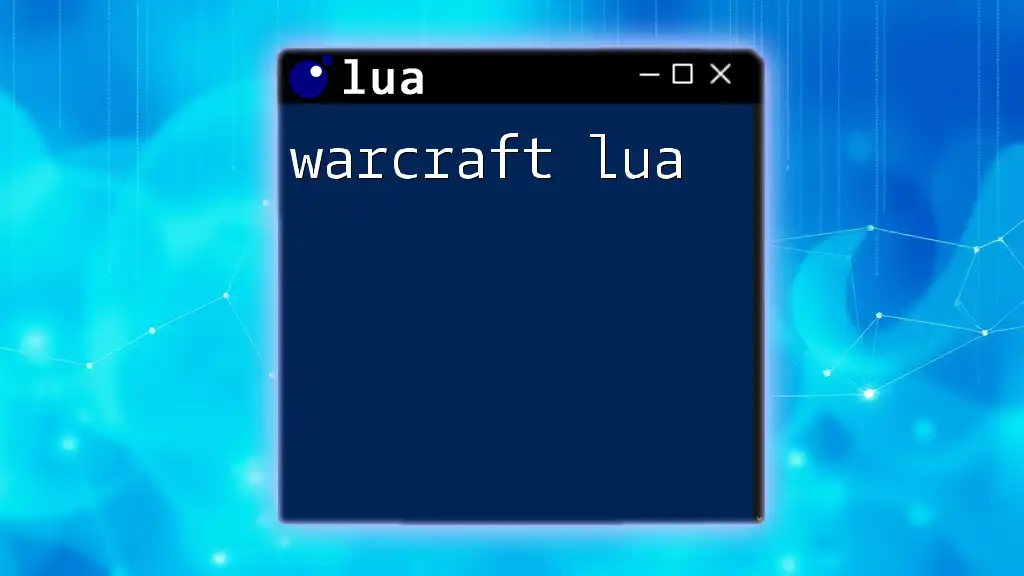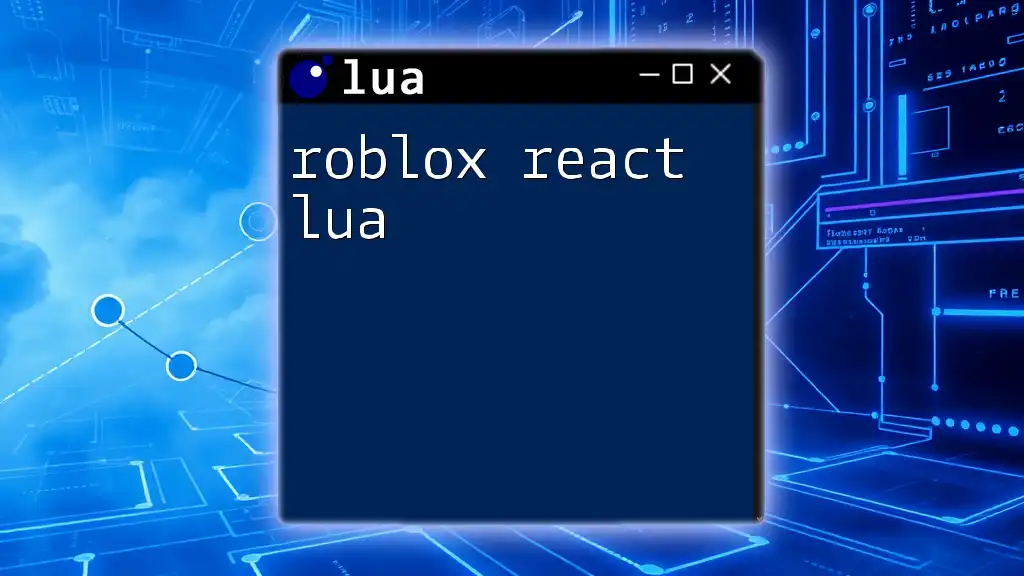Certainly! Here's a one-sentence explanation along with a code snippet in markdown format:
Warcraft Lua allows players to create custom scripts and add-ons for enhancing gameplay in Blizzard's World of Warcraft using a scripting language that is both powerful and concise.
-- Example of a simple World of Warcraft Lua command to print "Hello, World!" when the player logs in
local function OnLogin(event)
print("Hello, World!")
end
RegisterEvent("PLAYER_LOGIN", OnLogin)
Understanding Lua Basics
What is Lua?
Lua is a powerful, lightweight scripting language known for its easy integration with applications and fast execution. Originally designed for use in game development, Lua is an excellent fit for customizing World of Warcraft (WoW) through addons. Its key features include:
- Simplicity: Lua's syntax is straightforward, allowing even beginners to pick it up quickly.
- Flexibility: The language is adaptable and can handle a variety of programming paradigms, making it suitable for both functional and procedural programming.
- Extensibility: Lua allows developers to create libraries and modules, promoting modularity in code development.
Setting Up Your Environment
Before diving into Warcraft Lua, it’s essential to set up a proper environment for writing and testing your code. Below are the steps to get started:
- Choose an Editor: Popular text editors like Notepad++ and Visual Studio Code provide features that help in coding Lua, such as syntax highlighting and auto-completion.
- Install Necessary Addons: It's recommended to have some WoW addon libraries, like Ace3, for simplifying common tasks when writing Lua scripts.
- Basic Structure of a Lua Script: A typical Lua script in WoW includes functions, event registrations, and API calls. Understanding this structure is crucial for creating effective scripts.

Lua in World of Warcraft
The Role of Lua in WoW Addons
Lua plays a vital role in developing addons that enhance the gameplay experience in World of Warcraft. When combined with the WoW API, Lua provides the tools needed for UI customization and game mechanics improvement. Through Lua, players can create functional interfaces, automate tasks, and manipulate game elements according to personal preferences.
Core Concepts in WoW Lua
Event Handling
WoW is event-driven; certain actions in the game trigger events that you can respond to using Lua. Event handling is crucial in addons, as it allows developers to react to specific game states.
Here’s a simple example script that creates an event handler for PLAYER_LOGIN, which runs when a player logs into the game:
local frame = CreateFrame("Frame")
frame:RegisterEvent("PLAYER_LOGIN")
frame:SetScript("OnEvent", function(self, event)
print("Welcome to World of Warcraft!")
end)
This code snippet demonstrates how to create a basic frame that listens for the PLAYER_LOGIN event and prints a welcome message upon triggering.
Functions and Methods
Functions in Lua are blocks of code designed to perform specific tasks. They enhance code organization and reusability. Below is an example of a basic function that prints a welcome message:
function welcomeMessage()
print("Hello, Champion!")
end
welcomeMessage()
In this case, calling `welcomeMessage()` executes the function and outputs the message to the chat.
Working with the WoW API
API Overview
The WoW API is a set of pre-defined functions and methods that allow developers to access game data and functionality. Key namespaces include:
- Unit: Interacts with entity data like players and NPCs.
- Player: Provides specific details about the player character.
- ActionButton: Relates to the actions available in the game interface.
Commonly Used APIs
One common task is retrieving player information. For example, to fetch the player's current health, you can use:
local health = UnitHealth("player")
print("Your current health: " .. health)
This simple code snippet leverages the `UnitHealth` function to get the health value of the player and print it in the chat.

Creating Your First Warcraft Addon
Project Structure
To develop a Warcraft addon, you must set up a specific directory structure. The required files are:
- .toc (Table of Contents): This file tells WoW what files to load for your addon.
- .lua: The main script file containing your Lua code.
- .xml (optional): Used for defining the UI elements.
Writing Your First Addon
Step-by-step Guide
- Set Up the .toc File: Create a `.toc` file named `MyAddon.toc` with the following structure:
<InternalLink slug="react-lua" title="Getting Started with React-Lua: A Quick Guide" featuredImg="/images/posts/r/react-lua.webp" />
## Interface: 90005
<InternalLink slug="format-lua" title="Format Lua Like a Pro: Your Quick Guide" featuredImg="/images/posts/f/format-lua.webp" />
## Title: My First Addon
MyAddon.lua
- Write the Main Lua Script: Create a script named `MyAddon.lua` and start coding.
-- MyAddon.lua
print("My First Addon is loaded!")
- Testing Your Addon: Once you have the structure in place, load WoW, navigate to the Addons menu, and enable your newly created addon. You should see the message upon entering the game.
Testing and Debugging Your Addon
Debugging is an integral part of development. Use the built-in chat window to print debug messages and track variable states. Also, consider utilizing community tools, such as BugGrabber and BugSack, for error tracking and management.

Advanced Lua Techniques for Warcraft
Custom Functions and Libraries
As your skill grows, you may want to create reusable functions or even entire libraries. Organizing code into modules enhances reusability and maintainability. For example, creating a library to handle common tasks across multiple addons streamlines development.
Performance Optimization
Optimizing performance is crucial in Lua scripting. Here are some tips:
- Limit Redundant Calculations: Cache frequently used values instead of recalculating them.
- Event Throttling: Limit the frequency of event processing to avoid performance hits.
- Garbage Collection: Manage memory by ensuring you’re not keeping references to unused objects.
Handling Complex UIs
For more advanced development, you can manipulate complex user interfaces by combining Lua with XML. Creating custom frames, buttons, or panels allows you to tailor the user experience further. Below is an example skeleton for a custom frame:
local myFrame = CreateFrame("Frame", "MyCustomFrame", UIParent)
myFrame:SetSize(200, 100) -- Width, Height
myFrame:SetPoint("CENTER") -- Position
myFrame:Show()

Best Practices for Lua Scripting in WoW
Writing Clean Code
Maintaining readable and clean code is essential for long-term maintenance. Use meaningful variable names and consistent formatting. Commenting extensively can help both you and others understand your code's purpose and logic.
Staying Updated with WoW Changes
The developers of World of Warcraft routinely update the API. To keep your addons functional, stay informed about changes by following official patch notes and engaging with the lua_dev community. Participate in forums, Discord channels, and GitHub repositories dedicated to WoW addon development.

Resources for Further Learning
To continually improve your skills, consider exploring these resources:
- Books: Look for comprehensive guides on Lua programming and WoW addon development.
- Websites: Utilize sites like WoWInterface and CurseForge where you can find addon templates and community discussions.
- Forums and Community: Engage with fellow developers on platforms such as WoWInterface forums, Reddit, and Discord communities focusing on WoW development.

Conclusion
Understanding and utilizing Warcraft Lua can significantly enhance your gameplay experience and allow for personalized customization of the user interface. Start experimenting with different scripts and addons using the concepts outlined in this guide, and don't hesitate to interact with the vibrant community of developers as you progress. Each step taken in mastering Lua scripting brings you closer to transforming your WoW experience.

















